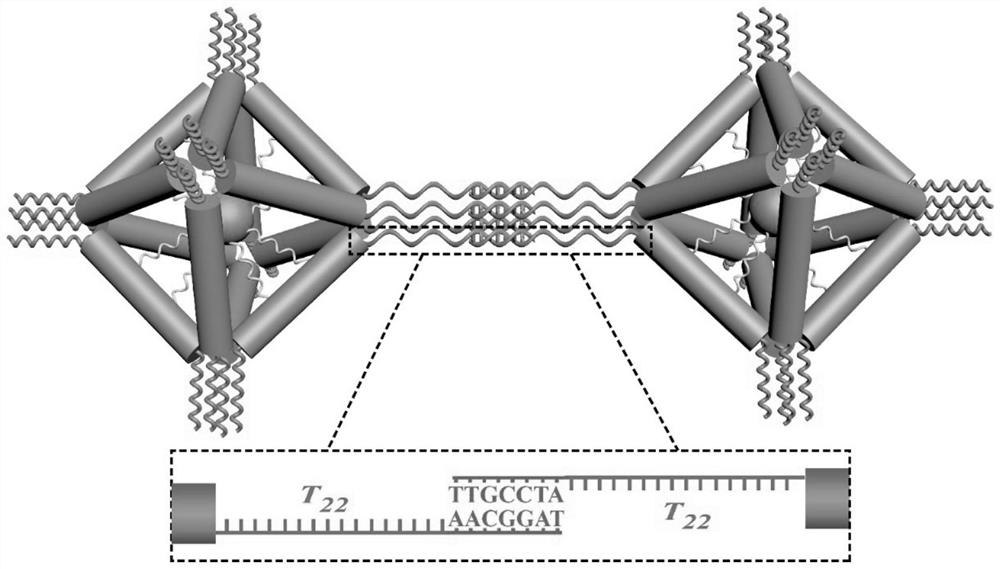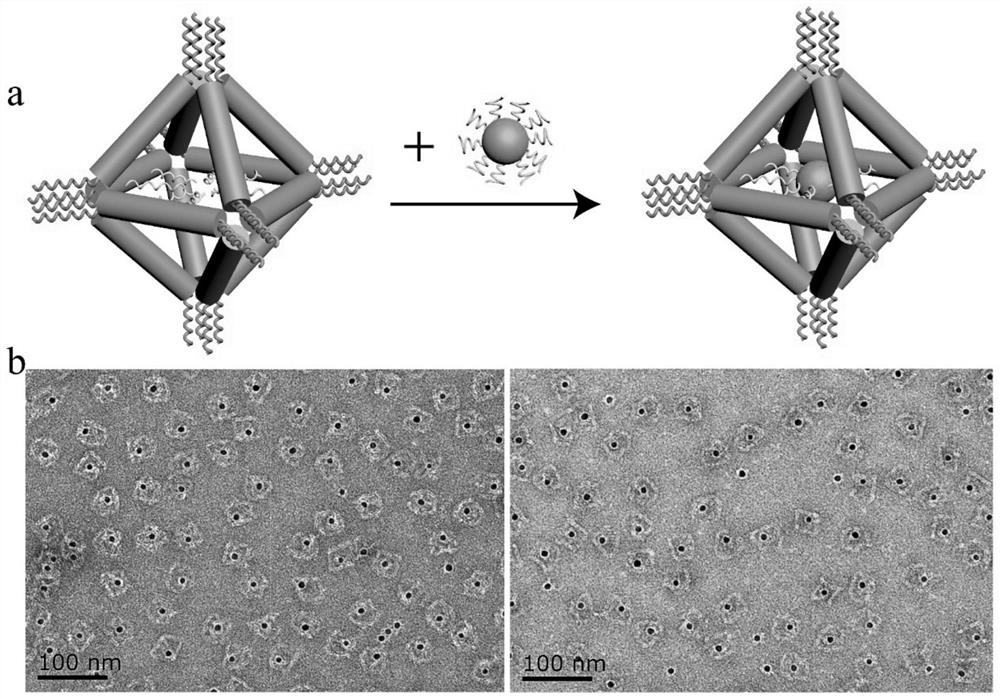Method for guiding nanoparticle superlattice by using DNA origami and DNA tiles
A nanoparticle and superlattice technology, applied in nanotechnology, nanomedicine, nanotechnology, etc., can solve the problems of limiting the adjustment of DNA origami spacing, soft crystals are easily affected by the environment, etc., to improve rigidity and compression resistance, The effect of improving overall rigidity
- Summary
- Abstract
- Description
- Claims
- Application Information
AI Technical Summary
Problems solved by technology
Method used
Image
Examples
Embodiment 1
[0024] A method of using DNA origami and DNA tiles to guide the nanoparticle superlattice of the present invention comprises the following steps:
[0025] (1) Synthesis of DNA origami octahedra: by mixing 10 nM M13mp18 scaffold DNA and 144 single-stranded DNA in a buffer containing 1 mM EDTA, 12.5 mM magnesium acetate, and cooling the mixed solution from 90 °C to room temperature for more than 20 hours Slow annealing to fold DNA origami octahedral framework; the molar ratio of M13mp18 scaffold DNA to single-stranded DNA is 1:10.
[0026] (2) Synthesis of DNA tile structure: by mixing complementary ssDNA in an equimolar ratio in 0.3 M PBS buffer, cooling the mixture from 95°C to room temperature within two days; DNA tile structure was synthesized; the PBS buffer Contains 0.3 M NaCl, 10 mM phosphate. The DNA tile structure is double-stranded DNA.
[0027] (3) Synthesis of 3D crystalline nanoparticle superlattices: DNA origami octahedrons prepared as described above were mixed ...
Embodiment 2
[0029] The difference between embodiment 2 and embodiment 1 is:
[0030] A method of using DNA origami and DNA tiles to guide the nanoparticle superlattice of the present invention comprises the following steps:
[0031] (1) Synthesis of DNA origami octahedra: by mixing 10 nM M13mp18 scaffold DNA and 144 single-stranded DNA in a buffer containing 1 mM EDTA, 12.5 mM magnesium acetate, and cooling the mixed solution from 90 °C to room temperature for more than 20 hours Slow annealing to fold the DNA origami octahedral framework; the molar ratio of M13mp18 scaffold DNA to single-stranded DNA is 1:20.
Embodiment 3
[0033] The difference between embodiment 3 and embodiment 1 is:
[0034] A method of using DNA origami and DNA tiles to guide the nanoparticle superlattice of the present invention comprises the following steps:
[0035] (1) Synthesis of DNA origami octahedra: by mixing 10 nM M13mp18 scaffold DNA and 144 single-stranded DNA in a buffer containing 1 mM EDTA, 12.5 mM magnesium acetate, and cooling the mixed solution from 90 °C to room temperature for more than 20 hours Slow annealing to fold the DNA origami octahedral framework; the molar ratio of M13mp18 scaffold DNA to single-stranded DNA is 1:15.
PUM
 Login to View More
Login to View More Abstract
Description
Claims
Application Information
 Login to View More
Login to View More - R&D
- Intellectual Property
- Life Sciences
- Materials
- Tech Scout
- Unparalleled Data Quality
- Higher Quality Content
- 60% Fewer Hallucinations
Browse by: Latest US Patents, China's latest patents, Technical Efficacy Thesaurus, Application Domain, Technology Topic, Popular Technical Reports.
© 2025 PatSnap. All rights reserved.Legal|Privacy policy|Modern Slavery Act Transparency Statement|Sitemap|About US| Contact US: help@patsnap.com



